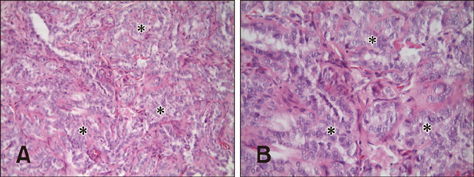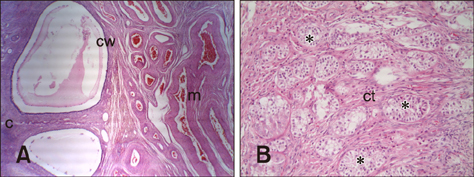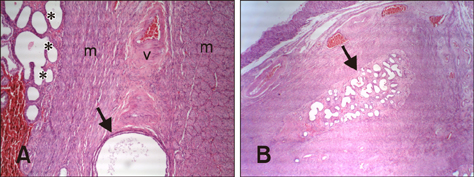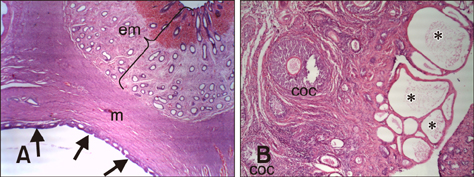J Vet Sci.
2017 Sep;18(3):407-414. 10.4142/jvs.2017.18.3.407.
Histopathologic findings in uteri and ovaries collected from clinically healthy dogs at elective ovariohysterectomy: a cross-sectional study
- Affiliations
-
- 1INCA-CES Research Group, School of Veterinary Medicine and Zootechny, CES University, Medellin 050021, Colombia.
- 2Veterinary Teaching Hospital, CES University, Envigado 0555427, Colombia.
- 3Research Group on Veterinary Sciences Centauro, School of Veterinary Medicine, Faculty of Agrarian Sciences, University of Antioquia, Medellin 050010, Colombia. juan.maldonado@udea.edu.co
- 4Laboratory of Veterinary Pathology, School of Veterinary Medicine, Faculty of Agrarian Sciences, University of Antioquia, Medellin 050010, Colombia.
- KMID: 2412459
- DOI: http://doi.org/10.4142/jvs.2017.18.3.407
Abstract
- Opinions on ovariohysterectomy (OHE) of bitches vary depending on region and country. In this descriptive, prospective cross-sectional study, uterine tracts and ovaries exhibiting gross pathologic findings (n = 76) were collected post-surgery from a reference population of 3,600 bitches (2.11% incidence) that underwent elective OHE during September to November 2013 and evaluated by histopathology examination. Data were evaluated by using descriptive statistics and chi-squared tests. Bitches were of crossbred background with average age 5 years (range 0.6-8.0 years) and most were nulliparous (69.7%) with no anamnesis of reproductive diseases (81.6%). Frequencies of proestrus, estrus, and diestrus were 42.1%, 6.6%, and 19.7%, respectively. The presence of mammary gland masses (5.3%) significantly correlated with histopathologic findings in ovaries and age of the bitch (p < 0.05). Predominant uterine histopathologies included cystic endometrial hyperplasia, periglandular fibrosis, lymphoplasmocytary endometritis, and adenomyosis (19.7%, 14.5%, 4.0%, and 2.6%, respectively). In ovaries, hyperplasia of rete ovarii, follicular cysts, oophoritis, adenoma of the rete ovarii, cysts of superficial structures, and granulosa cell tumors (10.5%, 10.5%, 7.9%, 4.0%, 2.6%, and 2.6%, respectively) were observed. The results reveal the presence of subclinical pathologies in healthy bitches, suggesting that OHE at an early age is beneficial for prevention of reproductive pathologies.
Keyword
MeSH Terms
-
Animals
Cross-Sectional Studies
Dog Diseases/pathology
Dogs
Endometrial Hyperplasia/pathology/veterinary
Endometritis/pathology/veterinary
Female
Hysterectomy/methods/*veterinary
Ovarian Diseases/pathology/veterinary
Ovarian Neoplasms/pathology/veterinary
Ovariectomy/methods/*veterinary
Ovary/*pathology/surgery
Uterus/*pathology/surgery
Figure
Reference
-
1. Arora N, Sandford J, Browning GF, Sandy JR, Wright PJ. A model for cystic endometrial hyperplasia/pyometra complex in the bitch. Theriogenology. 2006; 66:1530–1536.
Article2. Balka G, Szabó L, Jakab C. First report of an endometrial adenoacanthoma in a dog. Acta Vet Hung. 2011; 59:225–236.
Article3. Bhatti SF, Rao NA, Okkens AC, Mol JA, Duchateau L, Ducatelle R, van den Ingh TS, Tshamala M, Van Ham LM, Coryn M, Rijnberk A, Kooistra HS. Role of progestin-induced mammary-derived growth hormone in the pathogenesis of cystic endometrial hyperplasia in the bitch. Domest Anim Endocrinol. 2007; 33:294–312.
Article4. Bostedt H, Jung C, Wehrend A, Boryzcko Z. [Clinical and endocrinological findings of bitches with ovarian cyst syndrome]. Schweiz Arch Tierheilkd. 2013; 155:543–550. German.5. Brønden LB, Nielsen SS, Toft N, Kristensen AT. Data from the Danish veterinary cancer registry on the occurrence and distribution of neoplasms in dogs in Denmark. Vet Rec. 2010; 166:586–590.
Article6. Colimon KM. [Fundamentals of Epidemiology]. 3a ed. Medellín: Corporación para Investigaciones Biológicas;2010. p. 551. Spanish.7. Concannon PW, Spraker TR, Casey HW, Hansel W. Gross and histopathologic effects of medroxyprogesterone acetate and progesterone on the mammary glands of adult beagle bitches. Fertil Steril. 1981; 36:373–387.
Article8. De Bosscher H, Ducatelle R, Tshamala M, Coryn M. Changes in sex hormone receptors during administration of progesterone to prevent estrus in the bitch. Theriogenology. 2002; 58:1209–1217.
Article9. De Bosschere H, Ducatelle R, Vermeirsch H, Van Den Broeck W, Coryn M. Cystic endometrial hyperplasia-pyometra complex in the bitch: should the two entities be disconnected. Theriogenology. 2001; 55:1509–1519.
Article10. Ferreira de la Cuesta G. [Veterinary Pathology]. lst ed. Medellin: Editorial Universidad de Antioquia;2003. p. 526–530. Spanish.11. Gómez B, Ramírez M, Maldonado-Estrada J. Presence of lung metastases in bitches affected by malignant mammary neoplasms in Medellin (Colombia). Rev MVZ Cordoba. 2012; 17:2983–2990.12. González-Domínguez MS, Fernández LB, Saldarriaga S, Aranzazu-Taborda D, Maldonado-Estrada JG. [Infertility in a bitch with history of recurrent reproductive failure associated with granulosa cell tumor]. Rev Colomb Cienc Pecu. 2005; 18:258–268. Spanish.13. Groppetti D, Pecile A, Arrighi S, Di Giancamillo A, Cremonesi F. Endometrial cytology and computerized morphometric analysis of epithelial nuclei: a useful tool for reproductive diagnosis in the bitch. Theriogenology. 2010; 73:927–941.
Article14. Günzel-Apel AR, Buschhaus J, Urhausen C, Masal C, Wolf K, Meyer-Lindenberg A, Piechotta M, Beyerbach M, Schoon HA. [Clinical signs, diagnostic approach and therapy for the so-called ovarian remnant syndrome in the bitch]. Tierarztl Prax Ausg K Kleintiere Heimtiere. 2012; 40:35–42. German.15. Hagman R, Lagerstedt AS, Hedhammar Å, Egenvall A. A breed-matched case-control study of potential risk factors for canine pyometra. Theriogenology. 2011; 75:1251–1257.
Article16. Ichimura R, Shibutani M, Mizukami S, Suzuki T, Shimada Y, Mitsumori K. A case report of an uncommon sex-cord stromal tumor consisted of luteal and sertoli cells in a spayed bitch. J Vet Med Sci. 2010; 72:229–234.
Article17. Knauf Y, Bostedt H, Failing K, Knauf S, Wehrend A. Gross pathology and endocrinology of ovarian cysts in bitches. Reprod Domest Anim. 2014; 49:463–468.
Article18. Kustritz MV. Determining the optimal age for gonadectomy of dogs and cats. J Am Vet Med Assoc. 2007; 231:1665–1675.
Article19. Marino G, Barna A, Rizzo S, Zanghì A, Catone G. Endometrial polyps in the bitch: a retrospective study of 21 cases. J Comp Pathol. 2013; 149:410–416.
Article20. McEntee MC. Reproductive oncology. Clin Tech Small Anim Pract. 2002; 17:133–149.
Article21. McGavin MD, Zachary JF. Pathologic Basis of Veterinary Disease. 5th ed. St. Louis: Elsevier;2012. p. 1079–1092.22. McKay SA, Farnworth MJ, Waran NK. Current attitudes toward, and incidence of, sterilization of cats and dogs by caregivers (owners) in Auckland, New Zealand. J Appl Anim Welf Sci. 2009; 12:331–344.
Article23. Merlo DF, Rossi L, Pellegrino C, Ceppi M, Cardellino U, Capurro C, Ratto A, Sambucco PL, Sestito V, Tanara G, Bocchini V. Cancer incidence in pet dogs: findings of the Animal Tumor Registry of Genoa, Italy. J Vet Intern Med. 2008; 22:976–984.
Article24. Meuten DJ, editor. Tumors in Domestic Animals. 4th ed. Ames: Iowa State Press;2003. p. 176–179.25. Mir F, Fontaine E, Albaric O, Greer M, Vannier F, Schlafer DH, Fontbonne A. Findings in uterine biopsies obtained by laparotomy from bitches with unexplained infertility or pregnancy loss: an observational study. Theriogenology. 2013; 79:312–322.
Article26. Misdorp W. Progestagens and mammary tumours in dogs and cats. Acta Endocrinol (Copenh). 1991; 125:Suppl 1. 27–31.27. Nickel RF, Okkens AC, van der Gaag I, van Haaften B. Oophoritis in a dog with abnormal corpus luteum function. Vet Rec. 1991; 128:333–334.
Article28. Niskanen M, Thrusfield MV. Associations between age, parity, hormonal therapy and breed, and pyometra in Finnish dogs. Vet Rec. 1998; 143:493–498.
Article29. Ortega-Pacheco A, Gutiérrez-Blanco E, Jiménez-Coello M. Common lesions in the female reproductive tract of dogs and cats. Vet Clin North Am Small Anim Pract. 2012; 42:547–559.
Article30. Patnaik AK, Greenlee PG. Canine ovarian neoplasms: a clinicopathologic study of 71 cases, including histology of 12 granulosa cell tumors. Vet Pathol. 1987; 24:509–514.
Article31. Patsikas M, Papazoglou LG, Jakovljevic S, Papaioannou NG, Papadopoulou PL, Soultani CB, Chryssogonidis IA, Kouskouras KA, Tziris NE, Charitanti AA. Radiographic and ultrasonographic findings of uterine neoplasms in nine dogs. J Am Anim Hosp Assoc. 2014; 50:330–337.
Article32. Pena FJ, Gines JA, Duque J, Vieitez V, Martinez-Pérez R, Madejón L, Nuñez Martinez I, Moran JM, Fernández-García S. Endometrial adenocarcinoma and mucometra in a 6-year-old Alaska Malamute dog. Reprod Domest Anim. 2006; 41:189–190.
Article33. Pires MA, Seixas F, Palmeira C, Payan-Carreira R. Histopathologic and immunohistochemical exam in one case of canine endometrial adenocarcinoma. Reprod Domest Anim. 2010; 45:545–549.
Article34. Pretzer SD. Clinical presentation of canine pyometra and mucometra: a review. Theriogenology. 2008; 70:359–363.
Article35. Schneider R, Dorn CR, Taylor DON. Factors influencing canine mammary cancer development and postsurgical survival. J Natl Cancer Inst. 1969; 43:1249–1261.36. Sleeckx N, de Rooster H, Veldhuis Kroeze EJB, Van Ginneken C, Van Brantegem L. Canine mammary tumors, an overview. Reprod Domest Anim. 2011; 46:1112–1131.37. Smith FO. Canine pyometra. Theriogenology. 2006; 66:610–612.
Article38. Van Goethem B, Schaefers-Okkens A, Kirpensteijn J. Making a rational choice between ovariectomy and ovariohysterectomy in the dog: a discussion of the benefits of either technique. Vet Surg. 2006; 35:136–143.
Article39. Zanghì A, Catone G, Marino G, Quartuccio M, Nicòtina PA. Endometrial polypoid adenomyomatosis in a bitch with ovarian granulosa cell tumor and pyometra. J Comp Pathol. 2007; 136:83–86.
Article
- Full Text Links
- Actions
-
Cited
- CITED
-
- Close
- Share
- Similar articles
-
- Attenuated total reflection Fourier transform infrared as a primary screening method for cancer in canine serum
- Sterile Pyometra in Two Dogs
- A case of transient diabetes mellitus in a dog managed by ovariohysterectomy
- Evaluation of circulating IGF-I and IGFBP-3 as biomarkers for tumors in dogs
- Evaluation of circulating PD-1 and PD-L1 as diagnostic biomarkers in dogs with tumors







